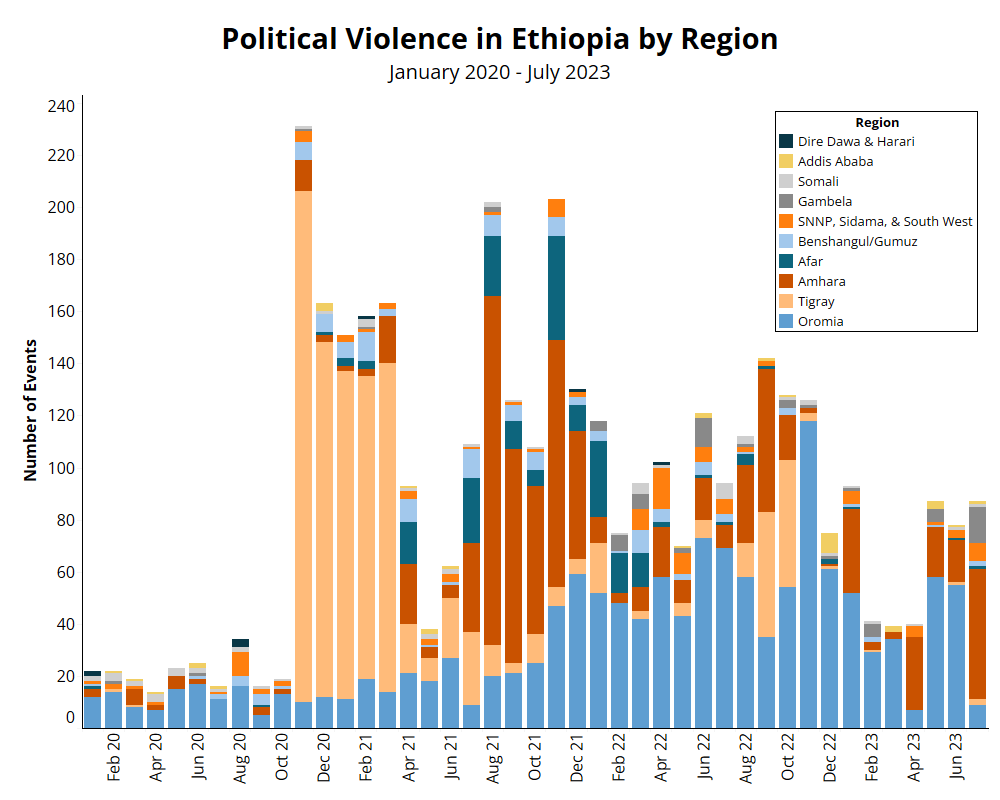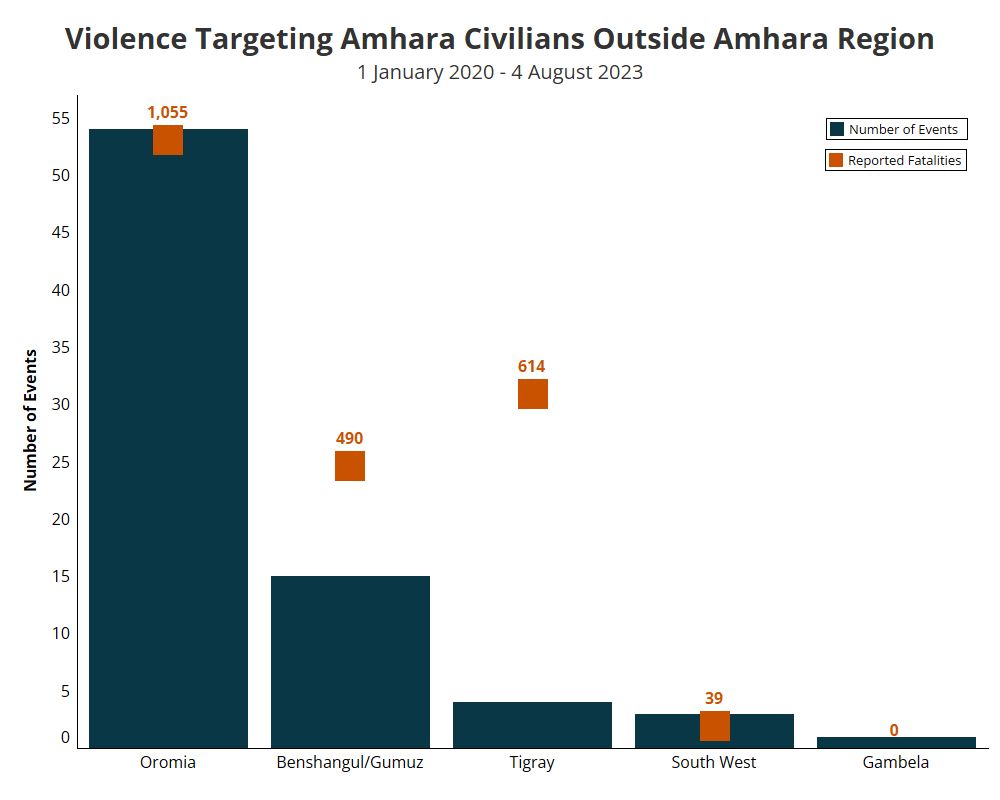Data as of 4 August 2023
- Violence is escalating in Amhara region, prompting the government to declare a state of emergency
- Nearly 30 clashes between government forces and Fano militias were recorded in Amhara last week, with most concentrated in North Wello and West Gojam zones, though fighting has been spread throughout the region.
- This marks an almost eightfold increase in armed clashes in the region relative to the weekly average since the start of the crisis in April
- While Amhara was among the least volatile regions in the country prior to the start of the northern Ethiopia conflict in 2021, it is now one of the most unstable
- Persistent insecurity in Amhara poses a significant threat to the federal government, the Abiy administration, and Ethiopia’s stability at large
Overview
Political violence has reached new levels of intensity in the northern Ethiopian region of Amhara, making it one of the most unstable areas in the country (see graph below). After the government announced controversial plans to integrate regional special forces into other security institutions at the beginning of April 2023, the region has seen increasing unrest and frequent clashes between state forces and Fano and Amharic ethnic militias. The crisis escalated when the federal government ordered the Ethiopian National Defense Force (ENDF) to take action against “extremist” elements after an unidentified armed group killed the head of the Amhara Prosperity Party1 at the end of April.2 Fano and Amharic ethnic militias demand that ENDF troops withdraw from the region and they accuse the regional and federal governments of being dominated by ethnic Oromos. Moreover, they demand that Welkait, Tselemt, Humera, and Raya – areas in Tigray region with large Amhara populations – be officially brought under the Amhara regional government.

ACLED records nearly 30 clashes between the ENDF and Fano militias last week, with most concentrated in North Wello and West Gojam zones (see map below). Fano militias managed to take control of some towns and released prisoners.3 Multiple violent demonstrations were also reported during the week, including incidents where demonstrators closed roads in Debre Markos, Dembecha, Bure, and Amanuel towns to obstruct ENDF movements in the region. According to one local official, clashes in East and West Gojam zones erupted when the ENDF began to mobilize toward east Amhara.4

Amhara regional authorities asked the federal government to respond to the unrest,5 and last Friday the Council of Ministers declared a six-month state of emergency in the region.6 The state of emergency includes limits on civil and political rights, such as imposing restrictions on demonstrations and allowing authorities to make arrests without a court order.7 The government indicated that, if deemed necessary, the state of emergency could also be implemented in other parts of the country.8
Despite the state of emergency, clashes between Fano militias and the ENDF have continued.9 Authorities have arrested a number of high-profile figures – including a member of the Amhara National Movement and the House of Representatives as well as the Addis Ababa City Council – in connection with the ongoing conflict.10
Background: Root Causes of the Conflict
Amhara is the second most populated region of Ethiopia, home to more than 30 million people. Amhara’s representatives have generally been strong supporters of Prime Minister Abiy Ahmed’s government, and they played a key role in the war with the Tigray People’s Liberation Front (TPLF) forces – also known as the Tigray Defense Forces – from late 2020 through 2022. During that time, the Fano and other Amhara ethnic militias fought alongside the ENDF against the TPLF and took control of contested areas, including parts of Western Tigray zone.
During and after the northern conflict, tensions grew between Amhara and federal forces around two central issues. First, political deadlocks on the status of Welkait, Humera, Tselemt, and Raya areas, which are officially located within Tigray region but contain many ethnic Amhara communities that seek to be incorporated into Amhara region. While the government indicated its interest in holding a referendum on the issue, opponents of the referendum argue that the TPLF-led government put these areas under Tigray region without consultation with the local population in the 1990s, and that the current administration should therefore make a direct political decision for these areas to be administered by Amhara region.11
The second issue is the overall state of security for Amhara communities in Ethiopia. Government forces did not consistently defend against the TPLF advance in the region during the northern conflict in 2021 and 2022 as the ENDF withdrew from towns and cities in Amhara and Afar. Amhara civilians faced abuses by TPLF forces during the war, and Amhara settlers also faced intermittent violence in Oromia and Benshangul/Gumuz regions (see graph below). The recent decision to eliminate regional special forces was regarded in Amhara as a threat to the region’s ability to protect itself against aggression from other regions. The government has also been accused of engaging in peace talks with the TPLF and the Oromo Liberation Front (OLF)-Shane, a rebel group in Oromia – also known as the Oromo Liberation Army – in a way that will prevent accountability for violence against Amhara communities.

Outlook
While unrest in Amhara region had largely been limited to demonstration activity prior to April 2023, violence has escalated since the government announcement of its regional special forces plan. Attacks on local officials have also increased, forcing some to flee their homes. Reports indicate that regional police and kebele militias may be aligning with Fano militias, further exacerbating the crisis.12
The conflict poses a significant threat to security in Ethiopia as the region’s support is a cornerstone of the Abiy administration, with Amhara often regarded as the sole stable regional partner for the federal government. The escalating violence is a further indication that the peace agreement with the TPLF did not include concessions to a silent third main party to the conflict – Amhara region – and that the solution to the problem will require resolving the issues of the contested areas in Tigray. This is a dangerous impasse, and the federal government is unlikely to emerge unscathed. Instead, it will likely need to balance between trading off current Amhara instability and support for the federal government with future Tigray instability and no expectation of support from Amhara region.
This fact sheet is adapted from a report by the Ethiopia Peace Observatory (EPO), a special ACLED project to enhance local data collection efforts and track political violence and peace initiatives across Ethiopia. For more information and analysis – both in English and Amharic – visit the EPO website.


Wolkait, Humera, etc. have always been Amhara and never belonged to Tigray.
In 1991, TPLF took these regions and put into Tigray region. The reason is obvious. The secessionist TPLF needed to include a fertile area into Tigray.
These areas were taken simply from the Amhara (at that time Gondar or Begiemeder province) without any consultation of the people.
Since then the Amharas in that region have been treated as second citizens.
There were several casualties which TPLF crushed.
TPLF tried to change the ethnic demography of those areas by committing torture etc to the Amhara.
The issue of these regions was an agenda on the table even before the Tigray war.
Few days after November 24, 2020 when the war in Tigray started (it started with the attack of TPLF on northern command of ETH), TPLF forces massacred civilian Amhara in Maicadra (in Wolkait region) where many hundreds of civilians were killed.
Amhara forces started to defend TPLF forces after this event in order to protect the Amhara population in Wolkait.
This was the beginning of the involvement of the Amhara forces and Fanno.